Not far from the busy streets of downtown Saigon, there is a place where the city moves at a gentler pace. At Binh Tay Market, mornings begin with the sound of soup simmering, the rustle of fabric being measured, and neighbors greeting each other like old friends.
In this guide, we’ll show you how to explore this Chinatown Saigon market. What locals buy. What tourists often regret. What’s worth tasting. And how to explore Chinatown market Ho Chi Minh like someone who belongs here.
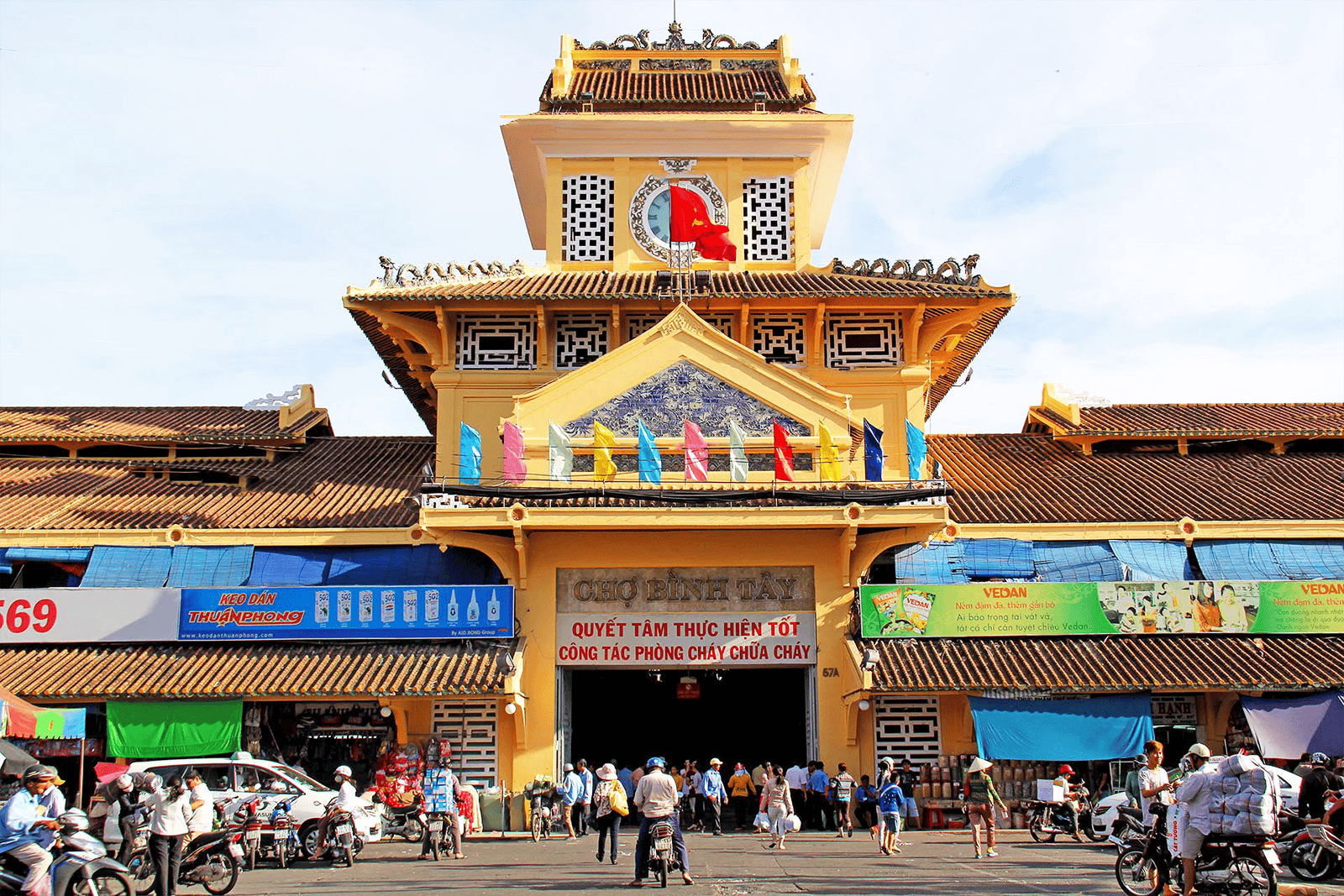
A brief history of Binh Tay Market
Binh Tay Market was officially completed in 1930 and remains one of the most important wholesale markets in Ho Chi Minh City. Its founder, Quách Đàm, was a Chinese immigrant from the Chaozhou region who arrived in Vietnam with nothing. He began by collecting recyclables and selling dried goods, slowly building a fortune through hard work and clever trade.
By the late 1920s, Chợ Lớn’s old central market had become overcrowded. Seeing an opportunity to help the community and shape a new commercial hub, Quách Đàm donated more than 25,000 square meters of land in Binh Tay village and personally funded the construction of a modern market made of reinforced concrete. In return, he only requested permission to build surrounding shop-houses for rental income and to place a statue of himself at the market’s center after his death.
The architecture of Binh Tay Market is a fusion of Eastern design and French colonial engineering. Its high ceilings, dragon-shaped fountains, central courtyard, and iconic four-faced clock tower were built for both function and symbolism. The original bronze statue of Quách Đàm, dressed in Qing Dynasty robes, once stood in the middle of the courtyard, surrounded by metal dragons and lotus ponds. It became a symbol of prosperity, and to many local vendors, Quách Đàm is still respected as a kind of “local God of Wealth.”
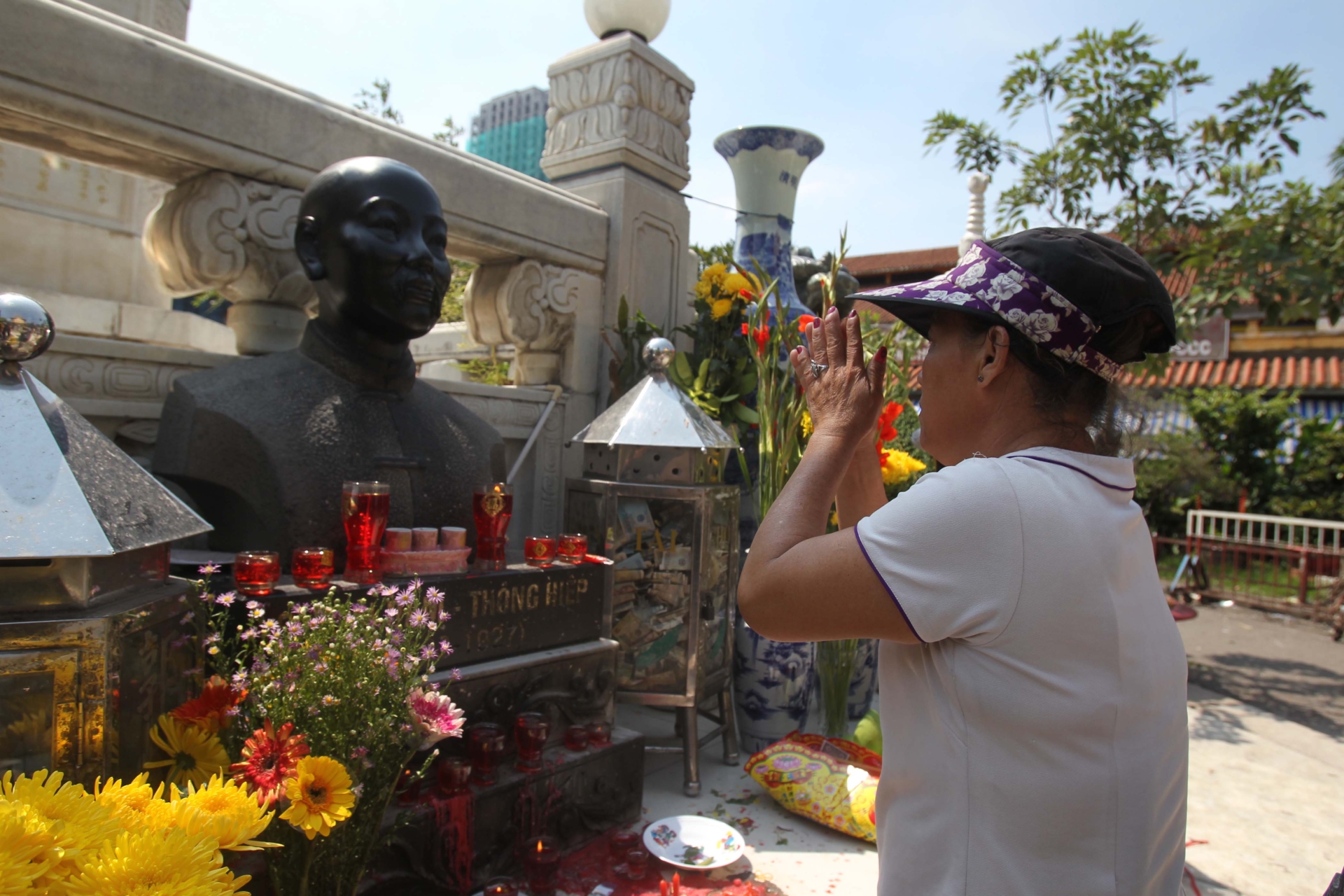
After 1975, the statue was removed and eventually relocated to the Ho Chi Minh City Museum of Fine Arts, where it is preserved today. In its place, vendors at the market erected a bust and small altar where they continue to burn incense daily.
Over the decades, Binh Tay Market has evolved but never lost its roots. It survived wars, economic shifts, and modern competition. With more than 2,000 active stalls, it remains one of the largest wholesale markets in southern Vietnam, especially for dried goods, textiles, and traditional ingredients. Every year, over 120,000 foreign tourists visit to experience its architecture, shop for authentic items, and connect with the deep local history of Chinatown Saigon.
What makes Binh Tay Market special?
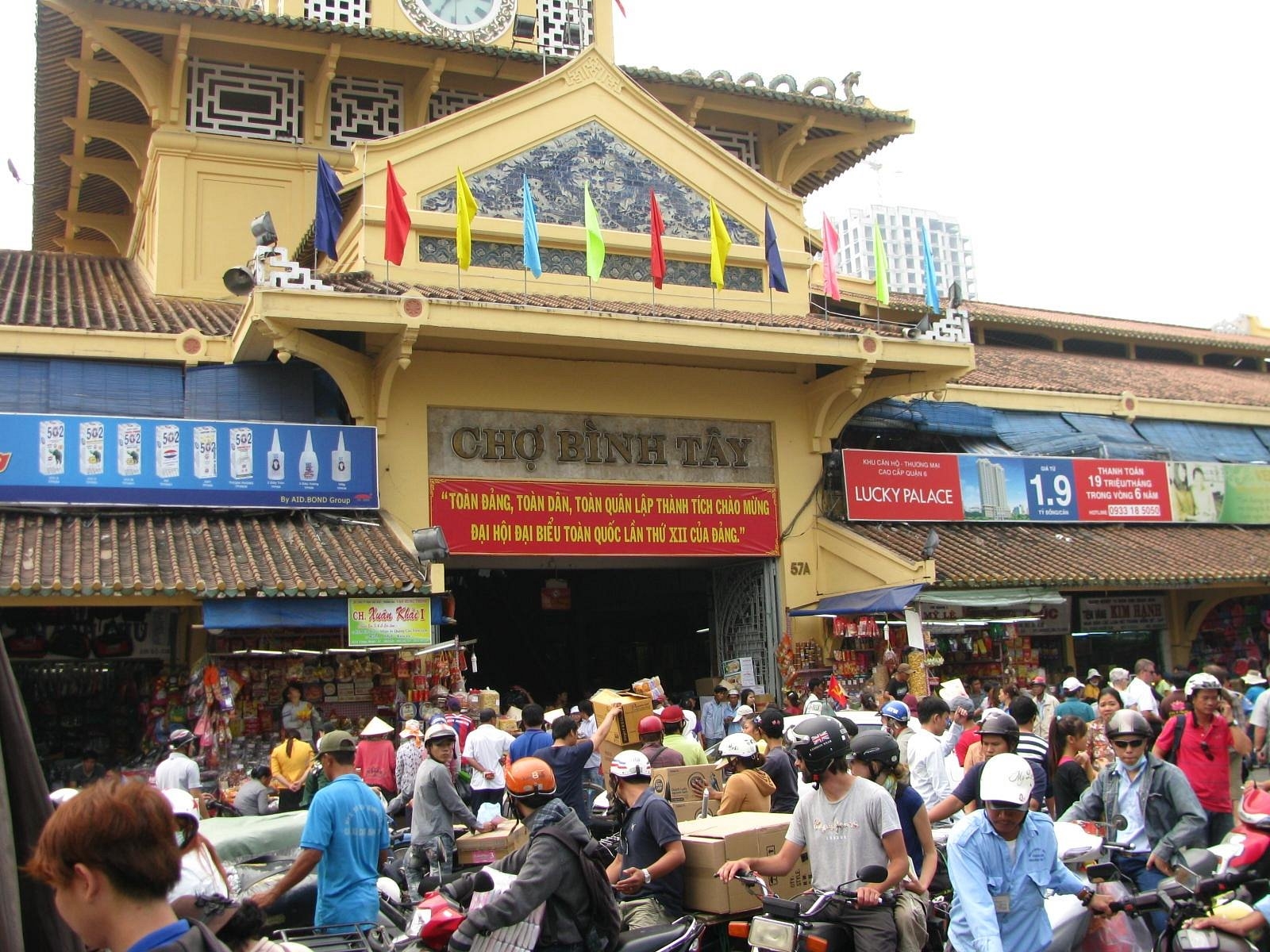
Unlike the tourist-heavy markets in downtown Ho Chi Minh City, Binh Tay Market offers a glimpse into real, everyday life. Located in the heart of Chợ Lớn, Saigon’s Chinatown, this market was built to serve both Vietnamese and Chinese communities, and it still does today.
Here, you won’t find vendors shouting at tourists or stalls overflowing with souvenirs. Instead, you’ll hear a mix of Vietnamese, Cantonese, and Teochew, see fabrics being measured by hand, and smell freshly ground spices in the air. The market opens early, with locals shopping for tofu, herbs, dried seafood, and household tools before the day gets too hot.
The atmosphere feels different. It is calmer, more focused. Under the tiled roofs, families have run the same stalls for generations. In the central courtyard, people stop to light incense at a small altar. It is a quiet tribute to Quach Dam, the market’s founder, still remembered and respected.
Binh Tay Market isn’t about performance. It is about rhythm, memory, and daily life that carries on even as the city grows around it.
How Binh Tay Market is organized
The outdoor wet market
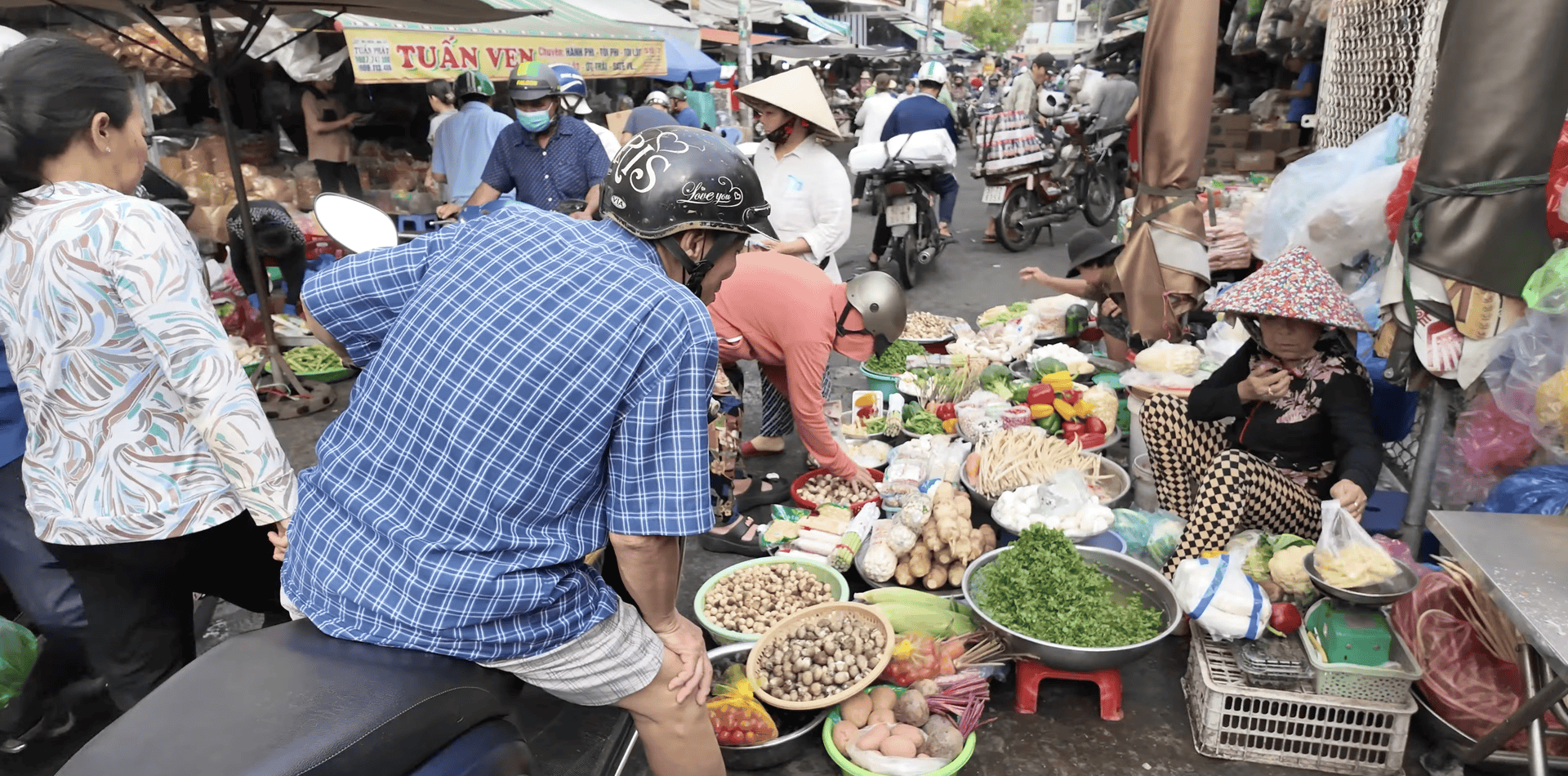
Just outside the main hall, the market opens into a lively wet market. This is where fresh fish glisten on ice, vegetables are sold in baskets, and herbs are bundled by hand. It’s more chaotic than the indoor section, but full of life and movement.
This area plays a big role in the Binh Tay Market food scene, especially early in the morning when home cooks and restaurant buyers come for the day’s ingredients. You’ll find everything from fish sauce to fresh tofu. It’s not polished, but it’s the part of the market where you can feel the energy of daily cooking.
The indoor market

Step inside the main building and you’ll enter a maze of narrow aisles, each filled with tightly packed stalls. This is the core of Binh Tay Market, where you’ll find dried seafood, herbal medicine, fabrics, enamel kitchenware, incense, and snacks. It feels cooler and quieter than the wet market outside, with shaded corridors and soft lighting from the tiled roof above.
Each row focuses on different types of products. One aisle might be dedicated to spices and tea, while another is full of fabrics in deep reds, blues, and golds. Some vendors sell plastic containers and household tools used in Vietnamese kitchens, while others offer candies and preserved fruits by the kilo.
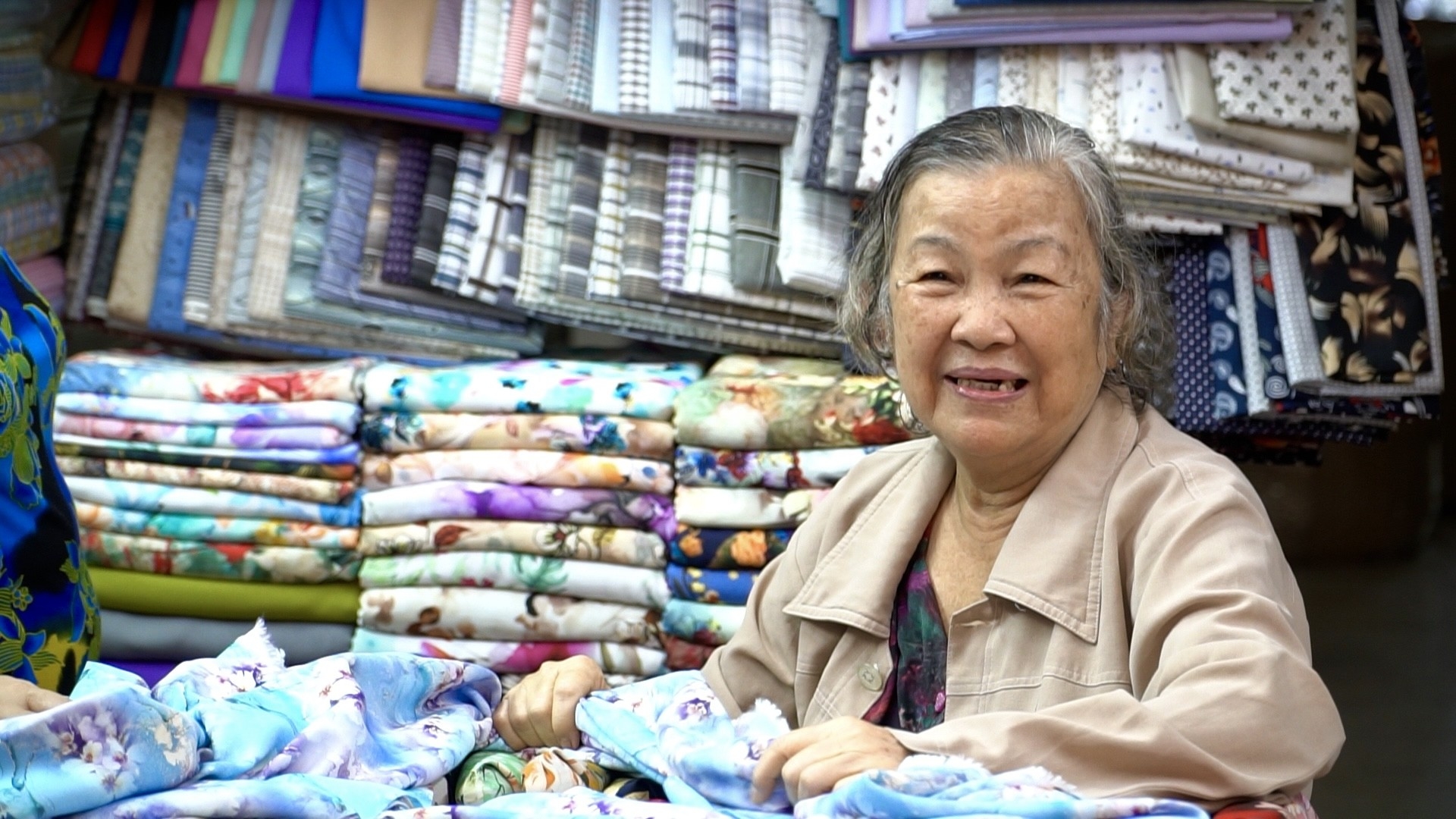
Most of the goods here are sold wholesale, which means they are intended for local shop owners to buy in bulk. However, tourists are welcome to purchase smaller amounts. Even if you don’t speak the language, vendors often use calculators and gestures to communicate.
This section shows how local people really shop. It is practical, efficient, and full of daily knowledge passed from one generation to the next.
The food court

At the center of Binh Tay Market is a quiet courtyard where locals gather to eat breakfast before starting their day. Small food stalls surround the space, serving bowls of noodles, sticky rice, grilled meats, and sweet desserts. You’ll see people sitting on low plastic stools, chatting while steam rises from pots of broth nearby.
This is one of the most authentic places to try Binh Tay Market food. Many of the vendors have cooked here for decades and know their customers by name. Menus are often handwritten or not posted at all, but you can simply point to what looks good or ask other diners for a recommendation.
The setting is simple and friendly. Meals are affordable, usually between 25,000 to 40,000 VND (around 1 to 1.5 USD). Even if you don’t plan to shop, stopping here for a local breakfast is worth the visit. The flavors, the quiet energy, and the familiar faces say more than any guidebook ever could.
Binh Tay Market directory
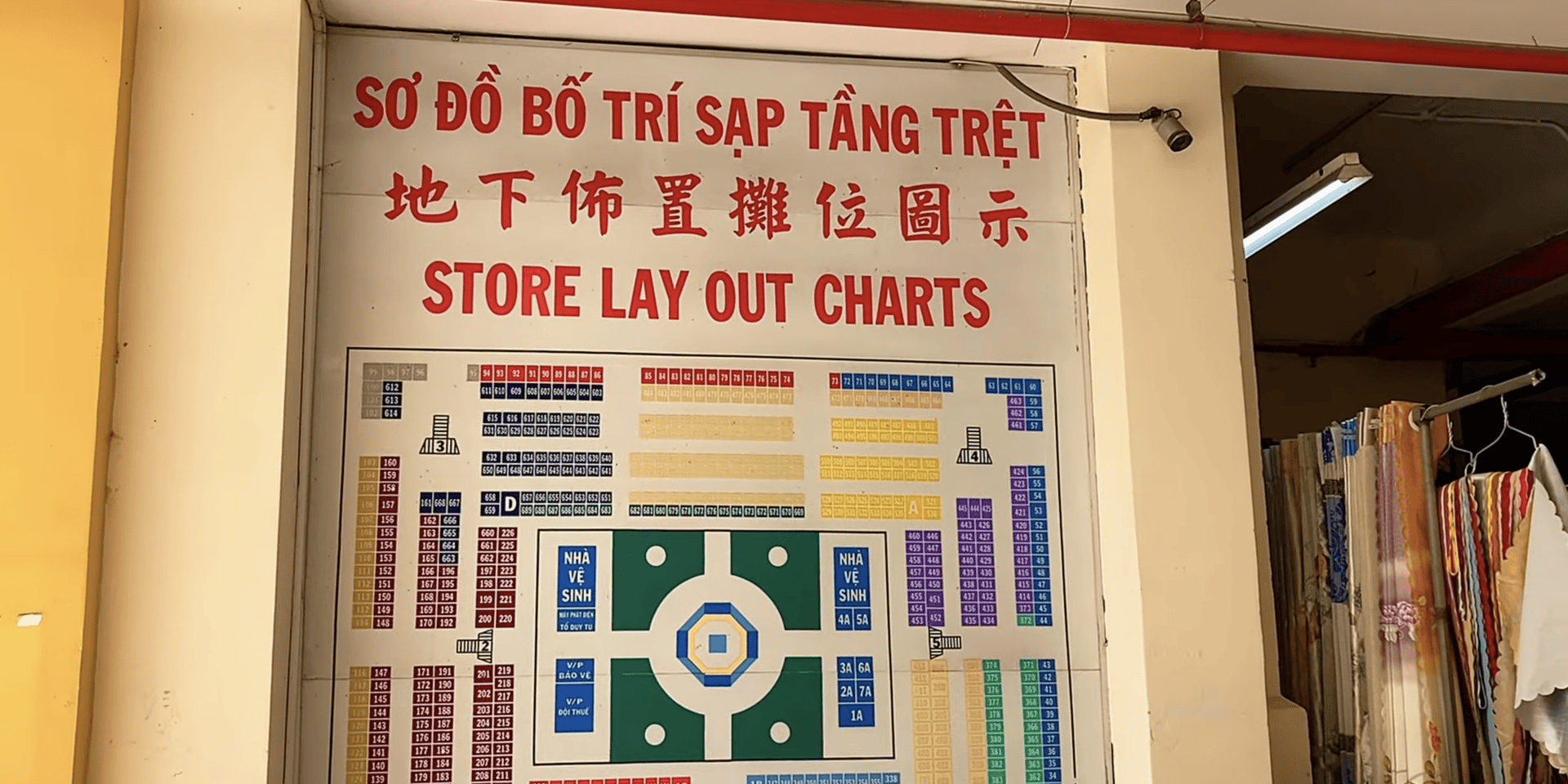
You can find a simple Binh Tay Market directory map at the main entrance. It shows where each section is located, from kitchen tools and spices to fresh seafood and local snacks.
But Binh Tay Market isn’t just one building. While the main hall has two levels of covered stalls, the market stretches out onto the surrounding streets as well. Each area offers a different window into local life:
-
Ground floor: Housewares, kitchen tools, dried spices, ceramics, shoes, hats, and jewelry.
-
Upper floor: Dried food, snacks, candies, and ready-made clothing.
-
Trần Bình Street zone: Fresh seafood, fruit, and vegetables.
-
Lê Tấn Kế zone: Dried seafood, betel leaves, cooking oils, and spices.
-
Phan Văn Khỏe zone: Fresh meat, tofu, river fish, frogs, and eggs.
You can use the map for orientation, but the best way to explore Binh Tay market is wandering. As you read through this guide, you’ll get to know the market step by step. Instead of rushing to find each zone, take your time and explore the market the way locals do.
What to buy at Binh Tay Market
Local spices and dried goods
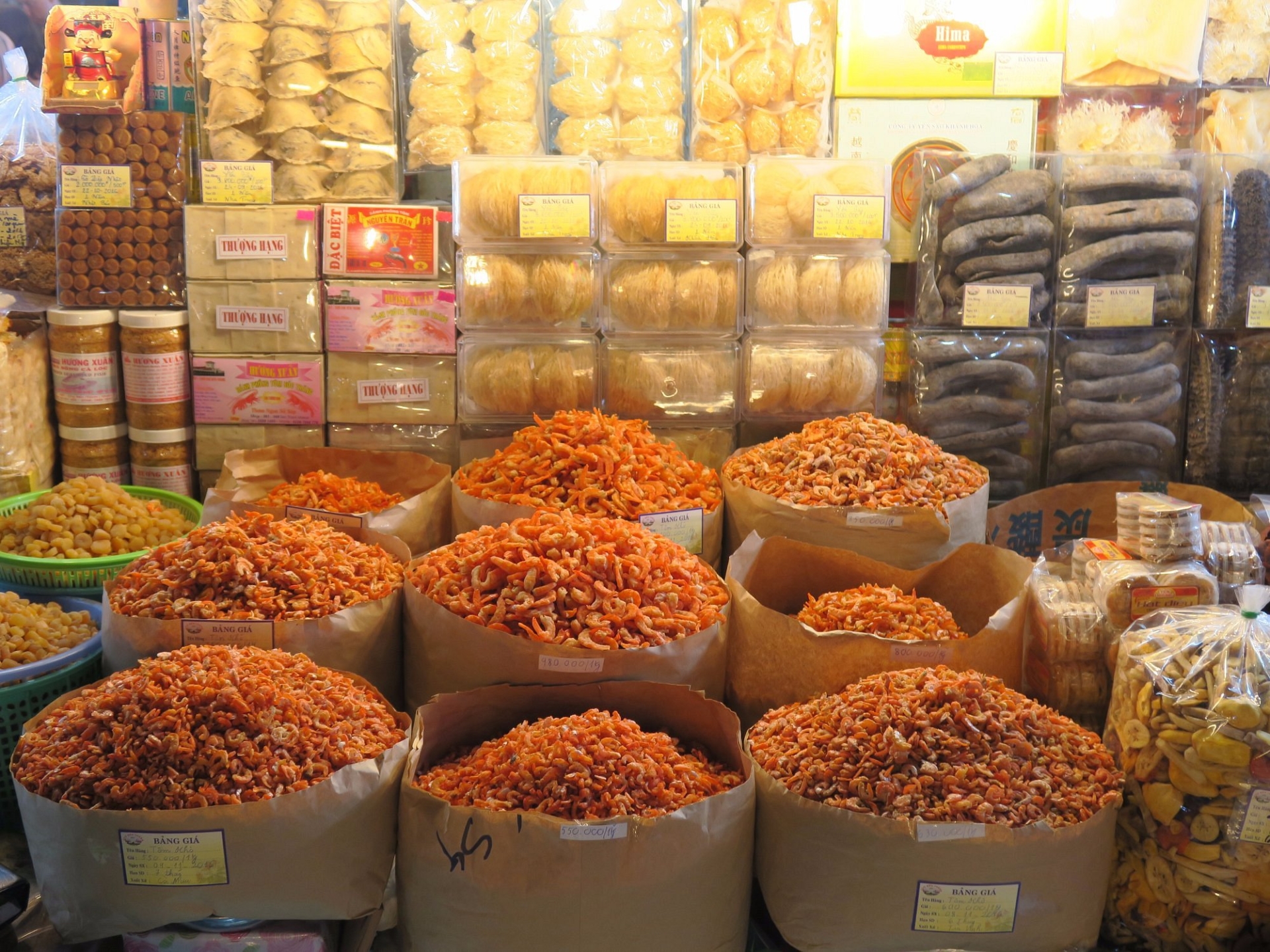
Binh Tay Market is one of the best places in Ho Chi Minh City to buy real Vietnamese cooking ingredients. In the indoor area, you’ll find stalls filled with star anise, cinnamon sticks, black cardamom, dried shrimp, lotus seeds, shiitake mushrooms, and more. Most items are sold by weight, not in branded packaging, just as locals prefer.
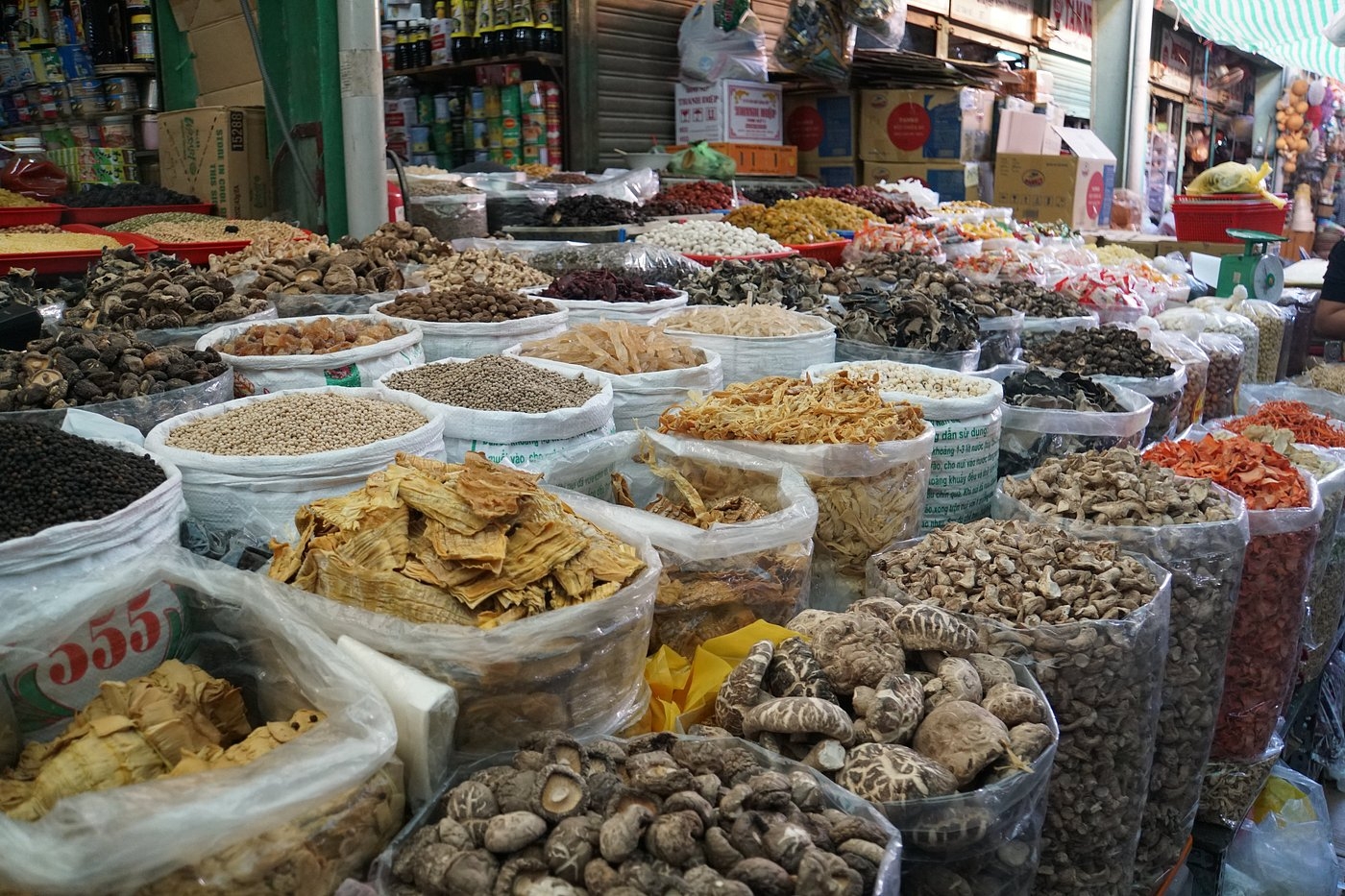
Alongside the spices are lotus seeds, dried mushrooms, and other preserved ingredients that show up in soups, stews, and herbal teas. Most of them are sold in bulk, stacked in plastic baskets or scooped into simple bags. The scent in this part of the market is warm, earthy, and full of cooking memories.
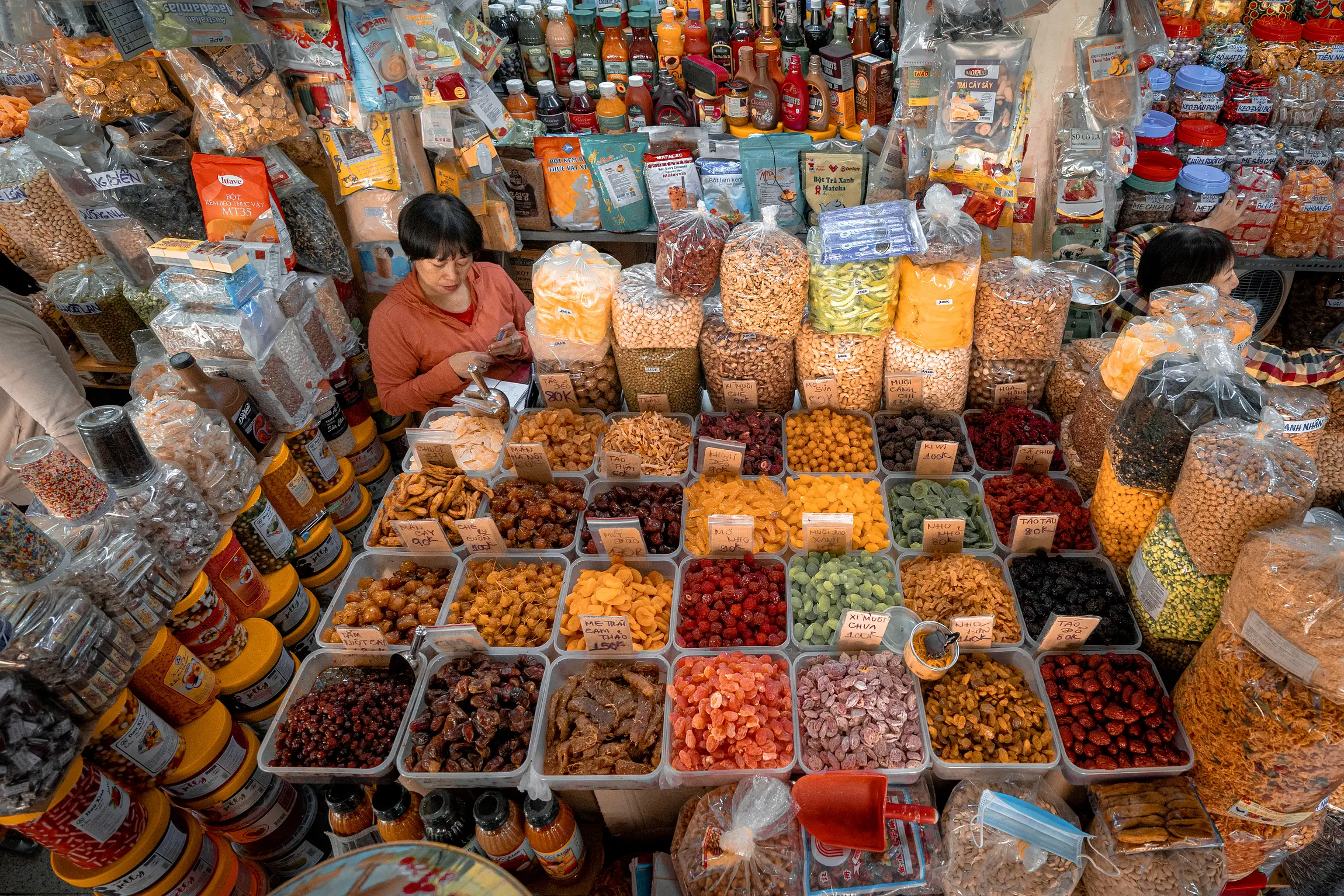
Scattered among the spice stalls, you’ll find local snacks like salted plums, dried mango, jackfruit chips, and preserved tamarind. These are favorites in Vietnamese homes. Most vendors are happy to measure out a small portion if you want to try a little of everything before choosing what to take home.
If you’re unsure what to choose, ask for a small sample or buy a little of everything. The vendors are used to local shoppers and may not speak English, but most are patient and friendly. These dried goods are light, easy to pack, and full of flavor, making them great souvenirs for travelers who love food.
Affordable household items

As you walk deeper into Binh Tay Market, you’ll notice rows of practical items used in Vietnamese homes. These include enamel bowls, bamboo trays, wooden utensils, plastic baskets, chopsticks, and traditional kitchen tools. Most are sold for daily use, not as souvenirs, which is why the prices are low and the designs are simple.
You might recognize some of these items from local restaurants or street food stalls. The same metal spoons, ladles, or serving bowls used by vendors across the city can be found here. Many travelers like to buy them as meaningful and useful souvenirs that bring a touch of Vietnam to their own kitchens.
Most items are lightweight and easy to carry in luggage. You will not see tourist packaging, but what you get is real. It is the same quality that local people use every day.
Traditional fabrics
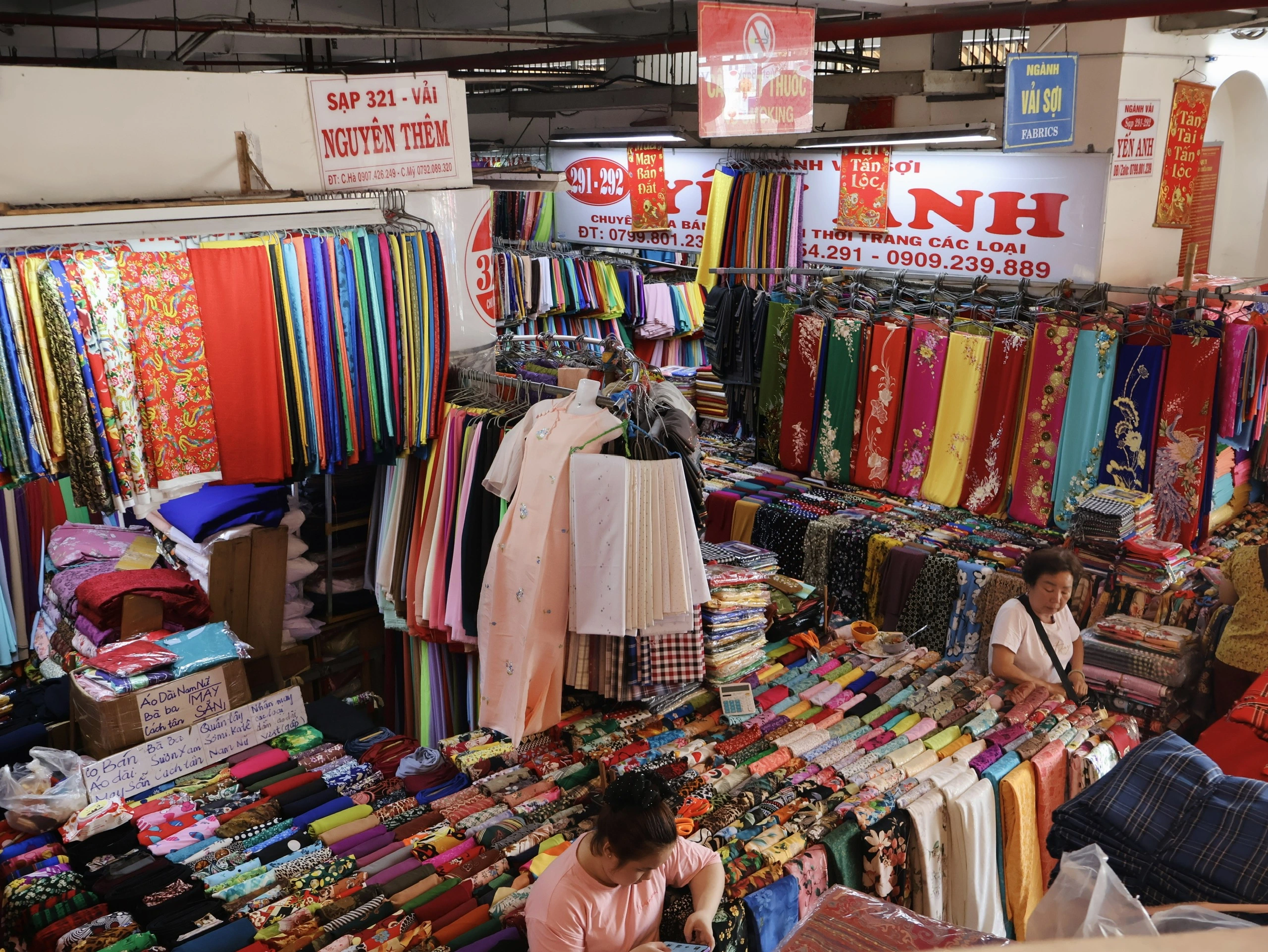
One quieter corner of the market is dedicated to fabric. Rolls of cotton, silk, and brocade stand upright in soft waves of color. Locals use these to make áo dài, table cloths, and altar covers. Vendors will cut fabric by the meter and often help you choose what fits your need or taste.
If you are looking for Binh Tay Market clothes, this is also the place to find simple everyday wear like loose cotton tops and patterned house pants that reflect daily Vietnamese fashion.
Some travelers bring back small pieces of fabric as gifts or souvenirs. Others buy a few meters to tailor their own outfits later on. And if you’re looking for inspiration on what to make with Vietnamese fabrics, this guide to Vietnamese traditional dress might give you a few beautiful ideas.
What not to buy at Binh Tay Market
Things tourists often regret buying
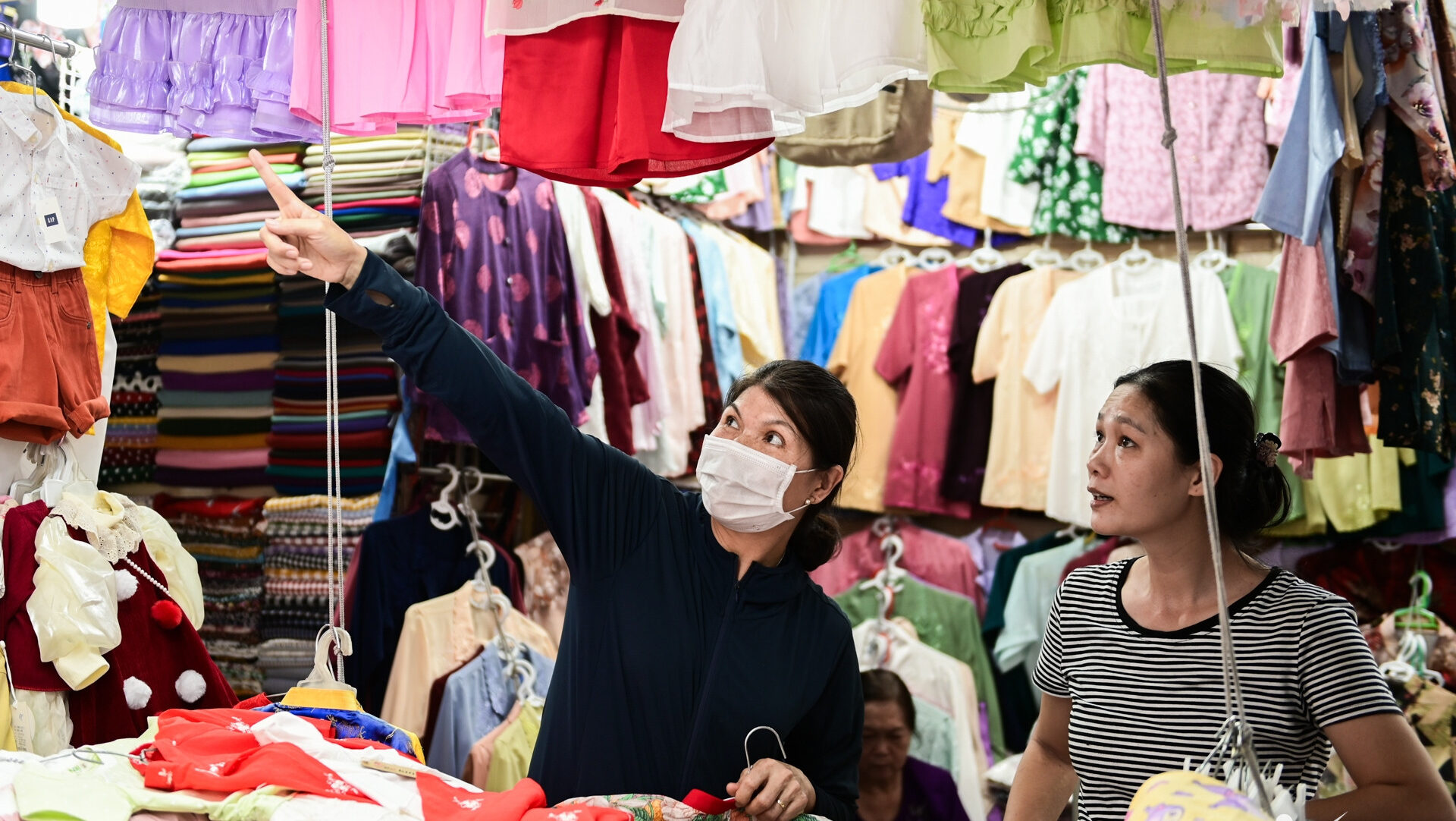
It’s easy to be drawn in by the colorful stalls at Binh Tay Market Saigon. Many travelers pick up souvenirs that seem charming at first but don’t hold up later. These often include lacquerware that peels, chopsticks in plastic wrap, or wooden crafts made in bulk.
Locals rarely buy these things. They pay attention to small details like weight, texture, and how a vendor speaks about the product. The most meaningful souvenirs are not always perfect. They are the ones that feel like part of daily life. A single spoon, a cloth pouch, or a tea cup chosen with care often carries more memory than a packaged set.
How to spot tourist traps

Most tourist-focused stalls at Binh Tay Market are located near the main entrances. These stalls often display similar products side by side, such as keychains, fridge magnets, lacquer boxes, or printed T-shirts. The layout may feel unusually tidy, and vendors might approach you quickly, even before you’ve shown interest.
One common sign of a tourist trap is when items have no price tags, and you are asked to “name your price” or are offered a high starting price that requires bargaining. Another sign is when the vendor speaks fluent English but does not seem to interact much with local customers.
In contrast, the best stalls are often quieter. The vendor may be folding fabric, preparing herbs, or chatting with regulars. These sellers may not speak much English, but they are focused on their work and treat all customers the same. If you feel welcomed without pressure and can take your time to browse, you’re likely in a more authentic spot.
How to explore Binh Tay Market like a local
Best time to go
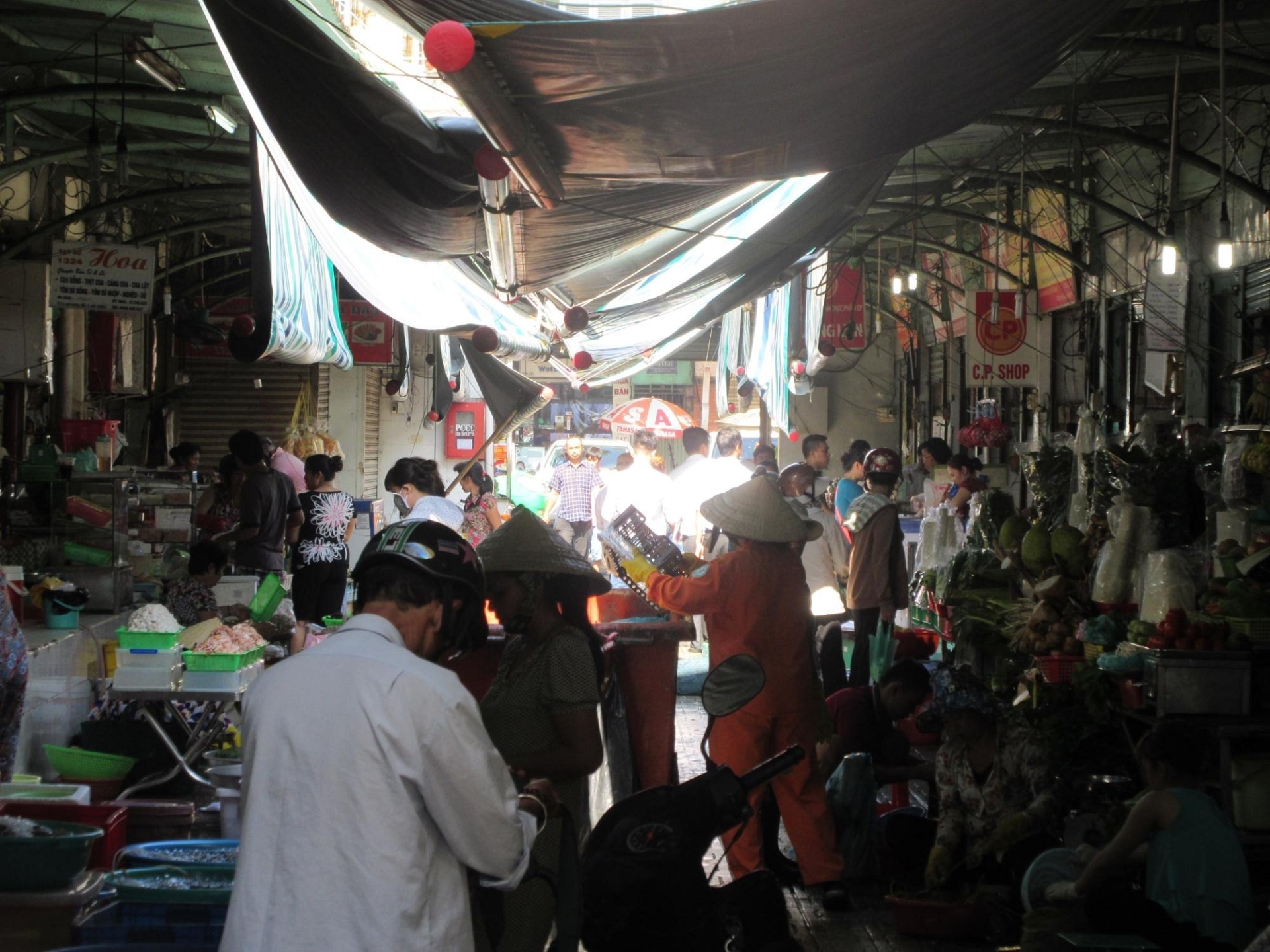
Binh Tay Market opens around 6:00 AM and stays active until late afternoon. The best time to visit is between 7:00 and 9:00 AM. This is when vendors are setting up their stalls, locals are having breakfast in the courtyard, and the pace feels relaxed and authentic.
By late morning, the market becomes more crowded and the temperature rises. If you want to take your time, enjoy the food, and see the market at its most local, come early. Most wholesale transactions happen in the morning, and some of the freshest items sell out by noon.
How to get there
Binh Tay Market is located at 57 Tháp Mười Street, District 6, Ho Chi Minh City about 7 kilometers west of downtown Ho Chi Minh City. Here are the best ways to get there:
- By taxi or ride-hailing app
The fastest and easiest way is to use a taxi or a ride-hailing app like Grab. Just enter “Binh Tay Market” or the full address, and you’ll be dropped off at the main entrance. This is the most comfortable option, especially if you’re coming from District 1 or 3.
- By bus
This is a low-cost way to explore the city like a local. Take a public bus to Cholon Bus Station, which is just a short walk from the market. You can use Google Maps to check which bus lines are closest to your hotel. Signs may be in Vietnamese, so using your phone for navigation will be helpful.
- By bicycle with a local guide (best for cultural experience)
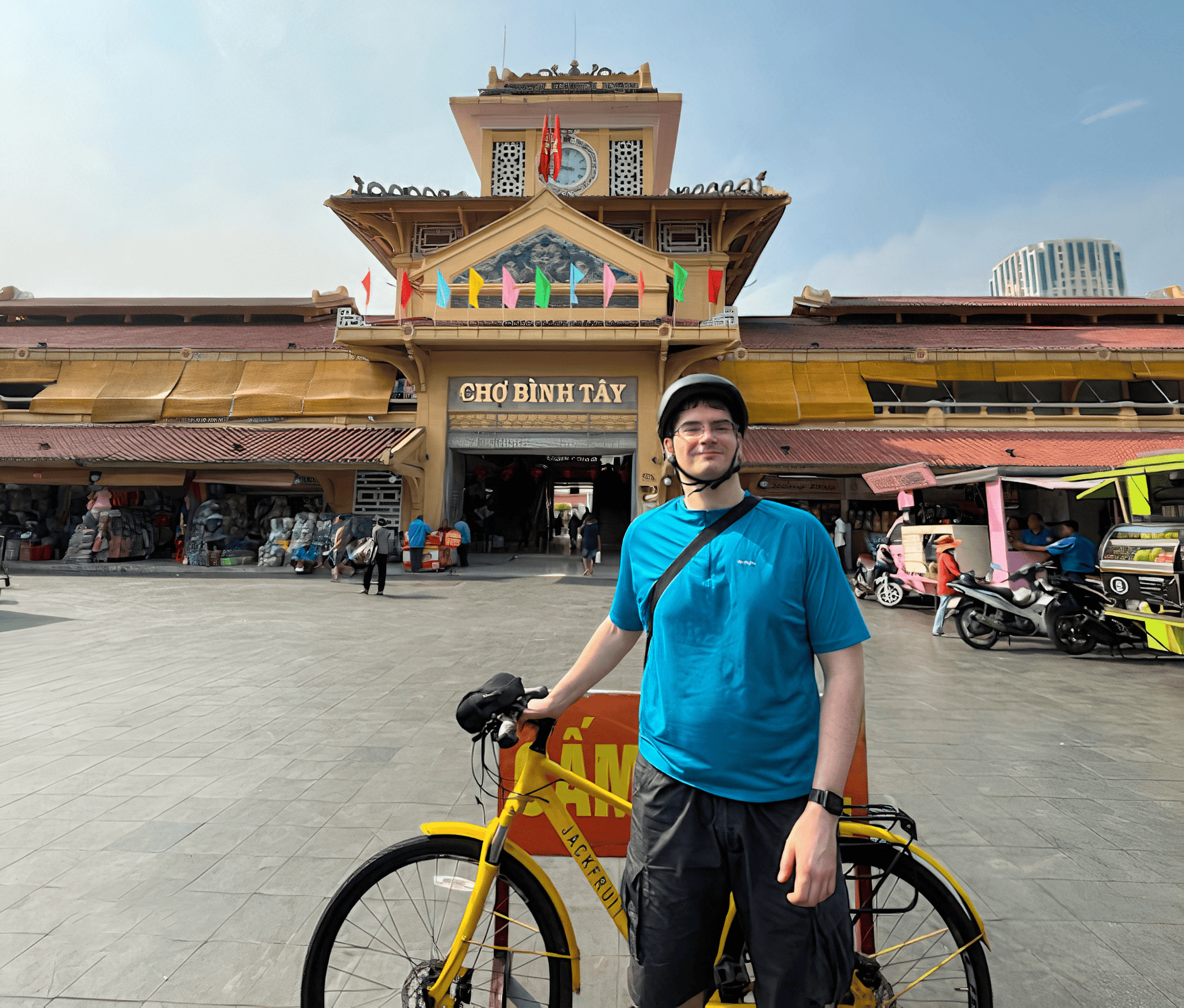
If you’re looking for a cultural experience, join our Trails of Quach Dam cycling tour in Ho Chi Minh City. This ride takes you through quiet alleyways, floating wharves, and morning markets, arriving at Binh Tay just as it comes alive. Along the way, you’ll taste tropical fruits, meet local vendors, and hear stories you won’t find in guidebooks.
Must-try foods at Binh Tay Market

The Binh Tay Market food is part of the heartbeat at Binh Tay Market. Before fabric stalls open, the courtyard is already full of steam, grill smoke, and morning chatter. Many vendors have been cooking here for decades, serving food that regulars return to every day.
Here are a few must-try dishes:
- Bánh mì by Ms. Loan (Vietnamese baguette)
Right in front of the market entrance, this small cart sells fresh bánh mì sandwiches every morning from 5:00 to 9:00 AM. Prices range from 15,000 to 25,000 VND (about $0.60 to $1 USD). Expect crispy bread, homemade fillings, and a loyal local crowd. - Bánh canh cua Châu Lan (Crab noodle soup)
This stall has been around for over 40 years. The soup is rich and thick with crab, served with soft tapioca noodles. It’s a popular breakfast dish, especially among older locals. A bowl usually costs around 35,000 to 40,000 VND ($1.40 to $1.60 USD). - Buffet-style rice stall by Ms. Nguyet
This local favorite offers over ten home-cooked dishes daily. You serve yourself from trays of braised pork, vegetables, and fried tofu, then pay by portion. A typical plate costs 35,000 VND ($1.40 USD). The stall has been open for more than 17 years, and you can even watch the food being prepared on-site. - Chè near the front of the market (Vietnamese sweet dessert)
Chè is a refreshing, colorful dessert made with coconut milk, beans, jelly, and more. If you want help choosing the right one, check out our guide to Vietnamese desserts in Saigon. - Phá lấu by Mr. Quang (Organ stew)
This dish features pork or beef organs slow-cooked in a spiced coconut milk broth. It’s bold in flavor, loved by locals, and definitely worth trying if you’re up for something new. A bowl costs about 25,000 VND ($1 USD).
Binh Tay Market food offers a chance to eat like a local without needing a guidebook. If street food is part of why you travel, we’ve shared more of our favorite local spots in this guide to Vietnamese street food in Saigon.
Binh Tay Night Market

As evening falls, Binh Tay Night Market brings a softer rhythm to the day. From around 5:30, the space in front of the main gate becomes a small street food hub. More than ten food carts line up, offering noodle soups, grilled skewers, and Vietnamese snacks.
Locals, especially young people, stop by for a quick meal or a casual hangout after work. The pace is slower than the daytime market. While a few stalls still sell everyday goods, most of the attention turns to food. It’s not as crowded as Ben Thanh’s night market, which makes it a more relaxed place to enjoy street food with local families.
Binh Tay Market vs Ben Thanh Market: Which is better?
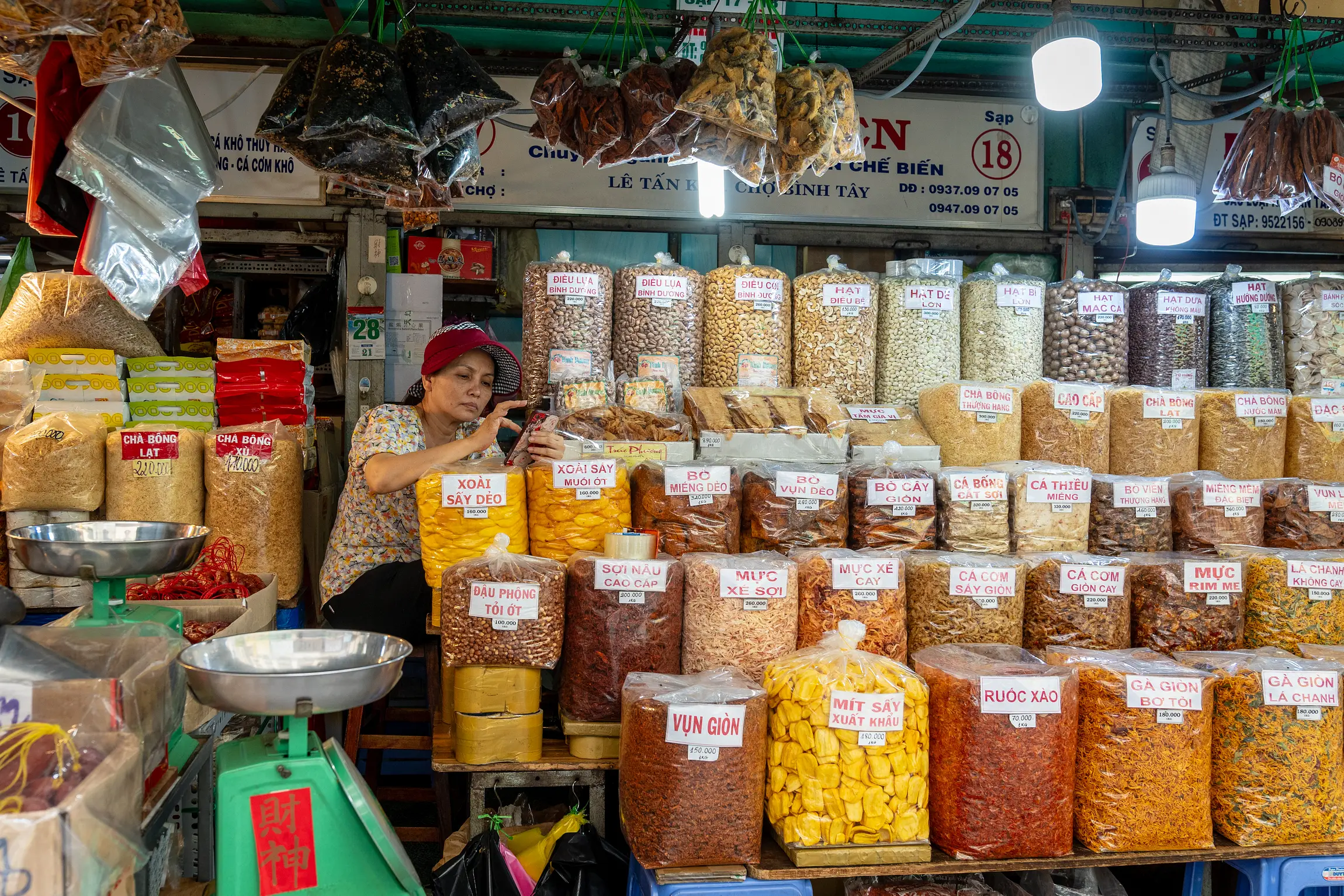
Ben Thanh Market sits in the heart of District 1 and is easy to reach. It’s popular with tourists, packed with souvenirs, snacks, and clothes. The atmosphere is lively, and bargaining is part of the fun. At night, it turns into a busy street food market that stays open late.
Binh Tay Market, by contrast, is tucked away in District 6, inside Cholon. It’s larger, more spacious, and built to serve locals. This is where you’ll find bulk spices, everyday kitchen tools, traditional fabrics, and simple Binh Tay Market clothes sold to neighborhood regulars. The food here is not staged for tourists. It’s the kind of food locals actually eat.
If you’re after something convenient and energetic, Ben Thanh is a good stop. But if you want to see how Saigon shops beyond the surface, Binh Tay offers something deeper. Visiting both gives you a fuller picture of the city.
Continue exploring hidden corners of Saigon with Jackfruit Adventure

Binh Tay Market is just one part of a much larger story unfolding inside Chợ Lớn (Chinatown). This neighborhood is filled with everyday moments that don’t ask for attention but reveal themselves when you slow down.
A few streets from the market, Cha Tam Church offers a quiet space to reflect among old walls that have witnessed generations pass through. In the evening, Phung Hung Market becomes a local street food spot where grilled skewers and cheerful conversations fill the air. You can find more of these quiet treasures in our guide to exploring Chinatown Saigon.
And if you’re ready to see a side of Saigon that few travelers do, our Saigon’s Off-the-Beaten-Path cycling tour takes you through smaller neighborhoods, past riverside homes, and into places that aren’t on typical maps.
The best places aren’t always marked on a map. They start with a shared dish, a glass raised among strangers, and a smile that turns into something familiar. And sometimes, they remember your face the next time you pass by.
If you’re searching for that kind of connection here in Vietnam, we’d be happy to ride with you.




